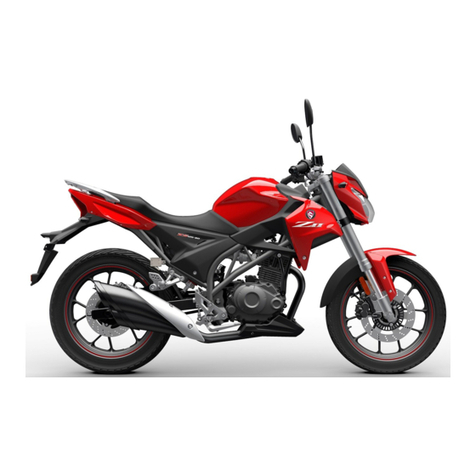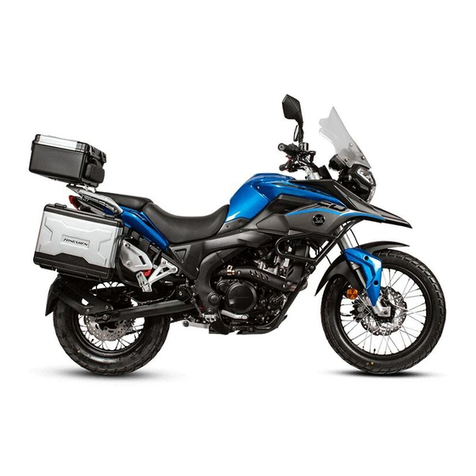
4
ENGLISH
Chapter 2 Knowledge about Maintenance
Section 1 Cautions
Subject to a breakdown, the motorcycle should be sent to an after-sales service station of the Company
or a professional motorcycle repair point. Besides, this Service Manual can be referred to for maintenance.
As the process of driving may cause components to be loosened and abraded to different degrees, without
proper maintenance, the motorcycle may be subject to decrease in power performance, economical
efficiency, reliability and security and also a shortened life. Therefore, proper maintenance can eliminate
breakdowns in a timely manner, extend the service life of motorcycle and reduce maintenance costs, for
purpose of driving safety.
[1.]For the maintenance of the motorcycle, please use original parts, accessories, lubricants and other
auxiliary materials manufactured or recommended by the Company. Use of parts that are not recognized
or recommended by the Company will affect the power performance, reliability, stability and comfort of the
motorcycle, and may further damage it.
[2.]For a reassembly after a disassembly, it is necessary to install a new washer, a sealing member and
a cotter pin, if applicable.
[3.]Bolts or nuts should be fastened in an order of diagonal cross, and gradually tightened 2 to 3 times
to reach a standard torque value as required.
[4.]To clean parts, the use of flammable cleaning solution is not allowed. Before assembly, the surface
of parts shall be wiped with lubricating oil or grease.
[5.]After assembly, check whether the parts are installed correctly by way of rotation, move, operation,
inspection, etc.
[6.]The dismantling of the motorcycle shall adopt special maintenance tools and commonly used
maintenance tools as provided.
[7.]The motorcycle shouldn’t be repaired until the flameout. In the case of maintenance with the
engine in operation, it must be conducted in a well ventilated site, as the waste gas exhausted from the
motorcycle contains toxic carbon monoxides (CO).
[8.]As gasoline is flammable and explosive, it is prohibited to smoke, ignite or shoot off fireworks in the
maintenance site.
[9.]The battery electrolyte contains sulfuric acid. Eyes, skins, and clothes, etc. accidentally splashed
with electrolyte can be rinsed by clean water thoroughly. In a severe case, please immediately seek
medical advice.
[10.]The storage battery will release hydrogen, which is flammable and explosive, so it is prohibited
to smoke, ignite or shoot off fireworks in the vicinity of the storage battery, especially when it is being
charged.






























